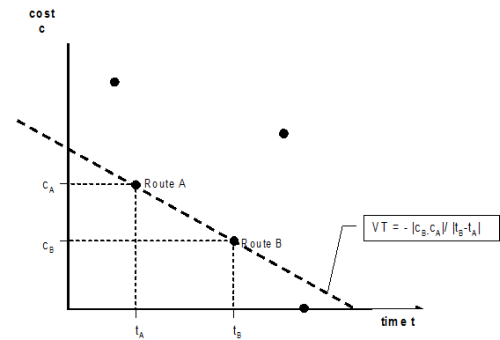The decisive feature of an assignment procedure is the impedance definition for route evaluation and route choice. In all toll-regarding assignment procedures, the impedance Rr of a route r consists of travel time tr and monetary costs cr:

Here, VT is the value of time in [€/h], for example. Though this equation applies to all toll-regarding assignment procedures, the TRIBUT procedure differs from other procedures in two properties:
- Monetary route costs can be calculated in different ways.
- The value of time VT is no constant value per demand segment, but VT is modeled as stochastic parameter that varies according to a particular probability distribution.
|
Note: In the context of TRIBUT procedures, it does not make sense to include the toll in the definition of impedance because TRIBUT takes the amount into account via the time value settings in the assignment parameters. |
The following describes the special features that apply when modeling tolls in TRIBUT assignments.
If TRIBUT methods are used, it does not make sense to include the toll in the definition of the impedance, because in the context of these methods the amounts are taken into account in the assignment parameters via the time value settings.
To model a link toll, the tolls must be defined in the link attribute Toll_PrTSys (User Manual: Creating a restricted traffic area). In principle, link-specific toll values are always taken into account in the TRIBUT procedures. An exception are toll values of links that are located in a restricted traffic area of the matrix toll type. Here the toll values are ignored.
The TRIBUT Equilibrium-Lohse procedure takes the area toll into consideration. It should be noted that toll values of links located in a restricted traffic area of the area toll type are taken into account. This means that the toll values of these links should be set to zero if only area tolls apply.
The matrix toll represents a special feature that is considered exclusively in the TRIBUT Equilibrium-Lohse procedure.
The Value of Time as stochastic parameter
Additionally, the TRIBUT procedure features the definition of the value of time (VT) and the impact of this definition (Table 144). This description is reduced to the link toll case, since the basic principle does not differ by toll type.
The complexity of a bicriterial route choice procedure is illustrated in a time-cost diagram:

Illustration 111: Time-costs diagram
- Each point on the diagram, for example A = (tA,cA), corresponds with a route of the same origin destination relation.
- A certain time value VT corresponds with a family of parallel straight lines with a negative slope.
- If two routes lie on one VT straight, they are ”equally good” (for a user with the same VT). This VT is also characterized as a critical VT for two routes.

